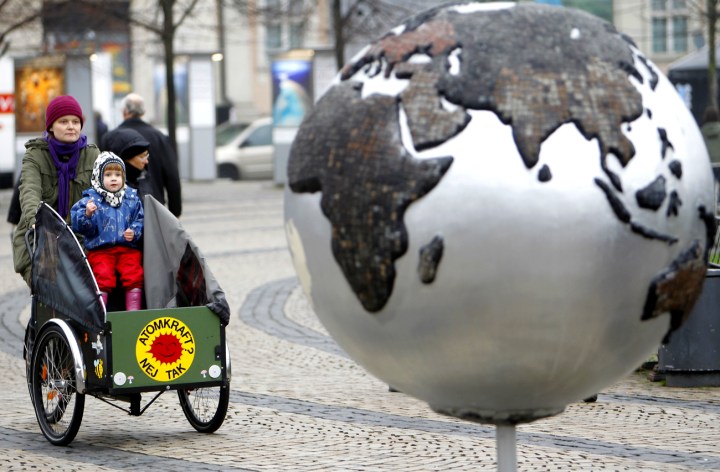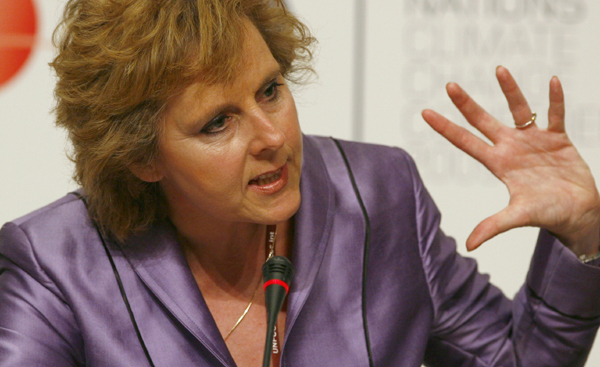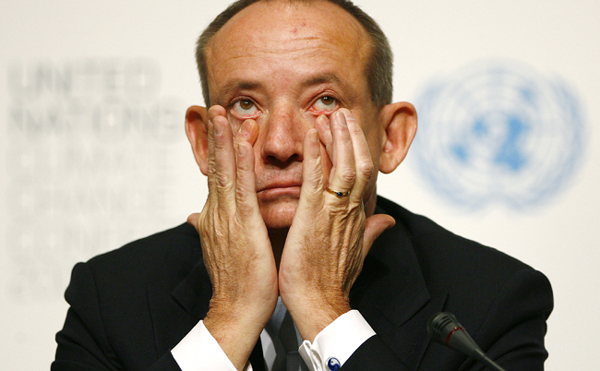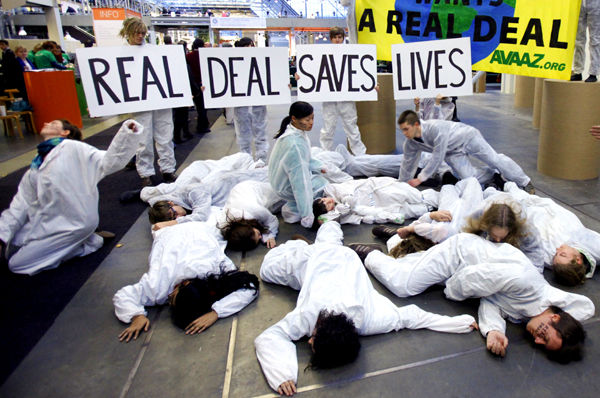Business Maverick, Politics, Sci-Tech
Copenhagen Chronicles: Day One

There have been two years of sharp-elbowed public and confidential negotiations and near-constant jockeying and public posturing to seize the high ground of moral principle on climate change. There has even been a spy scandal on climate research data, predictably called ClimateGate. But, finally, the most important-ever UN climate change conference in history opened on Monday in the Kingdom of Denmark, with a singular mission: to generate enough hot air to cool our planet.
In the days leading up to the conference’s opening session, UN organizers have been issuing stern warnings to the representatives of the 192 attending nations that this may be the best, last chance to strike a deal to protect the world from calamitous global warming. For people everywhere, but perhaps most especially those living in places like the Maldives or Kiribati – let alone the low-lying coastlines and river valleys on six continents home to billions, this may be a make-or-break moment for their collective futures. The two-week conference begins on an upbeat mood as a number of key large rich and emerging economies have stepped up with pledges to curb their greenhouse gases.
Many major issues remain unresolved, however. Conference president Connie Hedegaard said that one of the big ones is to find a way to raise and then channel public and private financing effectively to poor countries well into the future to assist these nations to deal with the effects of climate change. Hedegaard says, “This is our chance. If we miss it, it could take years before we got a new and better one. If we ever do.”

Photo: Conference President, Connie Hedegaard, attends the opening, December 7, 2009. REUTERS/Bob Strong
The Danish prime minister’s office says some 110 heads of state and government will attend the final days of the conference. Now that Barack Obama has said he will be attending at the end of the conference (and after he receives his Nobel Peace Prize in neighbouring Oslo, Norway), analysts read this as a sign international agreement is getting closer on the big issues.
The conference opened with video clips of children from around the globe urging delegates to help them grow up in a world without catastrophic warming as well as an all-girl choir accompanied by trumpet and harp. Beyond the meeting hall itself, a tumult of activists competes for press and delegate attention to their various campaigns against deforestation, or for clean energy and low-carbon growth.
The central issues are two: first is to reach a deal to begin weaning the world away from fossil fuels and other pollutants and directing global energy consumption to greener sources of energy. The second is to sort out mechanisms that can work to transfer the necessary hundreds of billions of dollars from rich to poor countries every year – over decades – to help less rich nations adapt to climate change and new, environmentally-friendly technologies.
Mainline scientists explain that failing such an agreement, the consequences of ever-rising temperatures will lead to the extinction of plant and animal species, the flooding of coastal cities, increasingly extreme weather events, drought and the spread of trans-border diseases and epidemics.

Photo: UN climate chief Yvo de Boer gestures during a news conference on the eve of the opening of the United Nations Climate Conference 2009 in Copenhagen December 6, 2009. REUTERS/Bob Strong
However, climate science took a major hit the other week with the controversy over hacked emails from the University of East Anglia that climate change sceptics insist proves scientists have been conspiring to hide evidence that doesn’t fit their theories. The ensuing debate has led some who oppose limits on greenhouse gas emissions, and at least one key nation, Saudi Arabia, unsurprisingly, to question the entire scientific basis for the Copenhagen talks.
The Climategate has further complicated the complex, multiyear, multinational diplomatic effort that is already ensnared in political, technical and financial disputes that some leaders say may make it impossible to reach a binding international climate treaty this year. Scientists retort that nothing disclosed so far – aside from the embarrassment of it all – undercuts the basic, peer-reviewed scientific work on climate change. Despite this scientific reassurance, polls in the US and Britain suggest the number of people who doubt now global warming is dangerous or is caused by humans continues to grow. These files stolen from East Anglia will almost certainly abet these beliefs.
While negotiations to set the stage for this conference have dragged on for two years, in recent weeks, new commitments from the US, China and India (among others) to control greenhouse gas emissions marked the tentative beginning of a breakthrough. While the first week of the conference will focus on the minutiae of the draft treaty’s lengthy text, real decisions will only come with the arrival in the second week of a flotilla of environment ministers, heads of state and head of government in the last several days leading up to Dec. 18 and the conference’s adjournment.

Photo: Members of NGOs stage a die-in protest before the opening of the conference. REUTERS/Bob Strong
Setting the scene, on Sunday, a UN Environment Program study said pledges from industrial countries and major emerging nations, in toto, are just short of the reductions of greenhouse gas emissions scientists believe are necessary to prevent average temperatures from rising more than 2 degrees Celsius.
Greenhouse gases warm the planet – sunlight filters through the atmosphere and the gases prevents the escape of some of the resulting heat. The atmospheric concentration of greenhouse gases released by humans has risen rapidly in the last century, in tandem with industrialization and electricity use. Spencer Weart, a physicist and historian notes, for example, “The physics of the greenhouse effect is so basic that instead of asking whether it would happen, it makes more sense to ask what on earth could make it not happen.”
Time magazine has picked out five key things to watch for when following the conference:
1. Will the U.S. lead?
The U.S. delegation to climate summits under former President George W. Bush played the spoiler nearly torpedoing the entire process two years ago in Bali. Under Obama, however, we can expect the US delegation to play a positive role in the talks. That’s key. However, the Obama administration must still obtain Senate confirmation for any treaty.
The range of emissions cuts Obama can bring to Copenhagen is based on cap-and-trade bills approved by the House of Representatives. However, the Senate may not vote on the bill until the spring. Thus, any progress in Copenhagen is provisional. Moreover, critics say the US cuts are still too low.
2. Will China and India follow?
Developing nations led by China and India will be responsible for the majority of future emissions. Under the earlier Kyoto Protocol, they are not required to take any verifiable actions to control emissions. Until recently, they haven’t shown much interest in doing so, but that may now be changing, with announcements about emissions cuts from both nations.
3. The two-step tango.
Back in 2007, negotiators worked out the “Bali road map,” a series of steps toward a successor to the Kyoto Protocol. Now, no one expects an actual treaty to be negotiated and signed in Copenhagen.
Instead there is a “two-step approach.” In the first step, world leaders would converge on a “political agreement” in Copenhagen. Then major countries like the US, Australia and Canada would have time to pass domestic carbon caps at home. In the second step, actual numbers could be entered into a treaty and quickly signed.
4. Seeing REDD on deforestation.
The loss of tropical forests plays a major role in climate change, contributing about 15% of global greenhouse gases, according to the most recent estimate. But deforestation has an environmental impact that goes beyond climate change – tropical forests are home to a wealth of diverse species, and when the trees are lost, wildlife follows.
Slowing the rate of deforestation has a double benefit, but currently there’s no mechanism for developing countries to earn carbon funding by keeping their trees. That could change in Copenhagen with the inclusion of REDD – Reduced Emissions from Deforestation and Degradation. What makes proponents is that REDD has broad support from both developed and developing countries.
5. Financing adaptation.
Combating climate change isn’t just about reducing carbon emissions. A key leg in the global treaty will address funding to help developing nations adapt to climate change – whether that means the building of seawalls, aid for agriculture during increasing droughts or the ability to better respond to natural disasters.
The White House now says there is an “emerging consensus” on the $10 billion-per-year figure, at least by 2012, but it isn’t clear how or who would distribute the money.
Over the next two weeks, there will be millions of pages of (hopefully recycled) paper devoted to analysis and commentary on Copenhagen – as well as the paper used by the conference. The Daily Maverick will try to distil the essence for readers to focus attention on the key issues, decisions and difficulties.
By J. Brooks Spector
In the meantime, read Time, the AP, the New York Times, Time and the conference website to get a running start on the issues and positions.
You can also read the full programme of all elements of the Copenhagen conference.
Main photo: A woman rides a bicycle past a globe in downtown Copenhagen December 7, 2009. The United Nations Climate Change Conference 2009, also known as COP15, is being held at the Bella center in copenhagen from December 7 – 18. REUTERS/Pawel Kopczynski

















 Become an Insider
Become an Insider